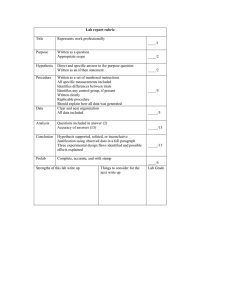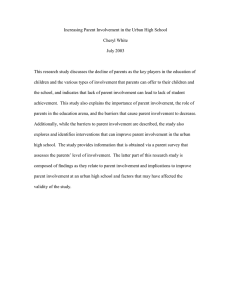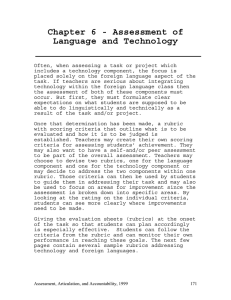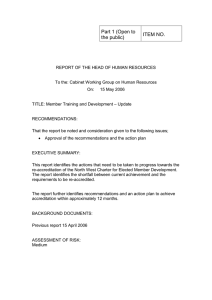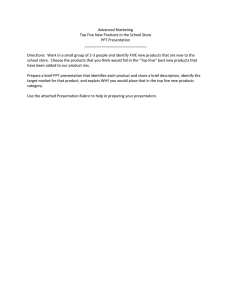Signature Assignments en () September 15, 2009
advertisement
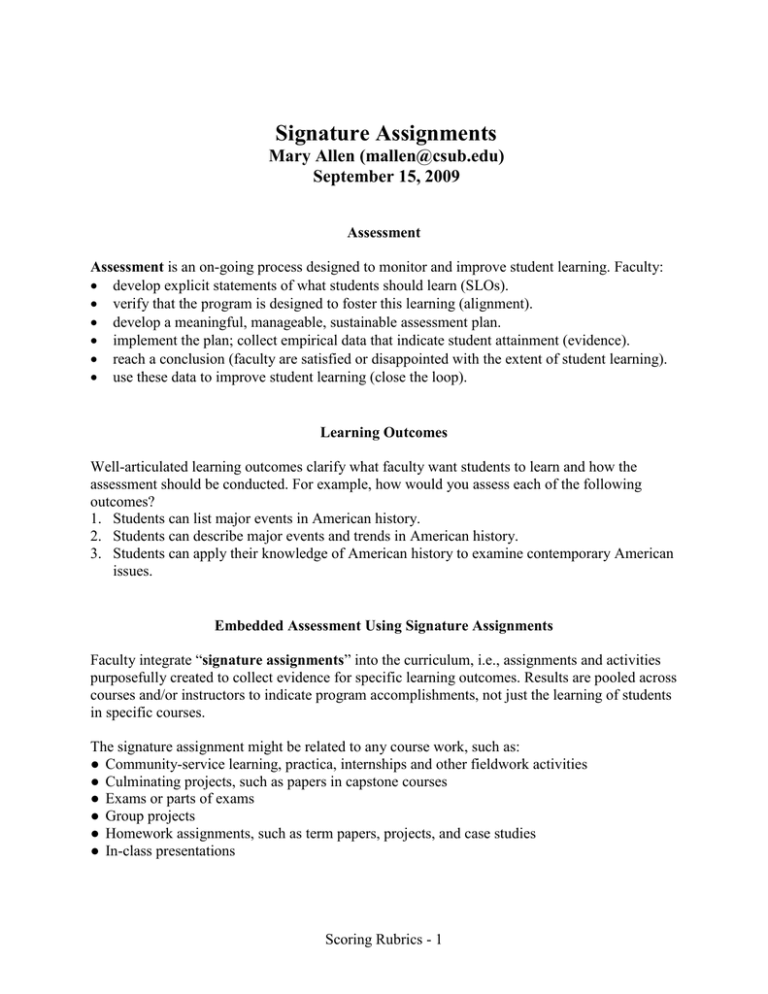
Signature Assignments Mary Allen (mallen@csub.edu) September 15, 2009 Assessment Assessment is an on-going process designed to monitor and improve student learning. Faculty: develop explicit statements of what students should learn (SLOs). verify that the program is designed to foster this learning (alignment). develop a meaningful, manageable, sustainable assessment plan. implement the plan; collect empirical data that indicate student attainment (evidence). reach a conclusion (faculty are satisfied or disappointed with the extent of student learning). use these data to improve student learning (close the loop). Learning Outcomes Well-articulated learning outcomes clarify what faculty want students to learn and how the assessment should be conducted. For example, how would you assess each of the following outcomes? 1. Students can list major events in American history. 2. Students can describe major events and trends in American history. 3. Students can apply their knowledge of American history to examine contemporary American issues. Embedded Assessment Using Signature Assignments Faculty integrate “signature assignments” into the curriculum, i.e., assignments and activities purposefully created to collect evidence for specific learning outcomes. Results are pooled across courses and/or instructors to indicate program accomplishments, not just the learning of students in specific courses. The signature assignment might be related to any course work, such as: ● Community-service learning, practica, internships and other fieldwork activities ● Culminating projects, such as papers in capstone courses ● Exams or parts of exams ● Group projects ● Homework assignments, such as term papers, projects, and case studies ● In-class presentations Scoring Rubrics - 1 Graduate Programs: Consider using comprehensive exams; thesis and dissertation proposals, drafts, projects, and defense sessions; internships/practica; and course exams and assignments. Rubrics are Used to Assess the Evidence when Subjective Judgments are Made There are two major types of scoring rubrics: Holistic scoring — one global, holistic score for a product or behavior Analytic rubrics — separate, holistic scoring of specified characteristics of a product or behavior Rubric Examples Portland State University Studies Program Holistic Critical Thinking Rubric* Inquiry and Critical Thinking Rubric Students will learn various modes of inquiry through interdisciplinary curricula—problem posing, investigating, conceptualizing—in order to become active, self-motivated, and empowered learners. 6 (Highest)—Consistently does all or almost all of the following: Accurately interprets evidence, statements, graphics, questions, etc. Identifies the salient arguments (reasons and claims) pro and con. Thoughtfully analyzes and evaluates major alternative points of view. Generates alternative explanations of phenomena or event. Justifies key results and procedures, explains assumptions and reasons. Fair-mindedly follows where evidence and reasons lead. Makes ethical judgments. 5—Does most the following: Accurately interprets evidence, statements, graphics, questions, etc. Thinks through issues by identifying relevant arguments (reasons and claims) pro and con. Offers analysis and evaluation of obvious alternative points of view. Generates alternative explanations of phenomena or event. Justifies (by using) some results or procedures, explains reasons. Fair-mindedly follows where evidence and reasons lead. 4—Does most the following: Describes events, people, and places with some supporting details from the source. Make connections to sources, either personal or analytic. Demonstrates a basic ability to analyze, interpret, and formulate inferences. Scoring Rubrics - 2 States or briefly includes more than one perspective in discussing literature, experiences, and points of view of others. Takes some risks by occasionally questioning sources or by stating interpretations and predictions. Demonstrates little evidence of rethinking or refinement of one’s own perspective. 3—Does most or many of the following: Respond by retelling or graphically showing events or facts. Makes personal connections or identifies connections within or between sources in a limited way. Is beginning to use appropriate evidence to back ideas. Discusses literature, experiences, and points of view of others in terms of own experience. Responds to sources at factual or literal level. Includes little or no evidence of refinement of initial response or shift in dualistic thinking. Demonstrates difficulty with organization and thinking is uneven. 2—Does many or most the following: Misinterprets evidence, statements, graphics, questions, etc. Fails to identify strong, relevant counter arguments. Draws unwarranted or fallacious conclusions. Justifies few results or procedures, seldom explains reasons. Regardless of the evidence or reasons, maintains or defends views based on self-interest or preconceptions. 1 (lowest)—Consistently does all or almost all of the following: Offers biased interpretations of evidence, statements, graphics, questions, information, or the points of view of others. Fails to identify or hastily dismisses strong, relevant counterarguments. Ignores or superficially evaluates obvious alternative points of view. Argues using fallacious or irrelevant reasons and unwarranted claims. Does not justify results or procedures, nor explain reasons. Exhibits close-mindedness or hostility to reason. X—No basis for scoring. (Use only for missing or malfunctioning portfolios.) *taken verbatim from Stevens, D. D., & Levi, A. J. (2005). Introduction to Rubrics. Sterling, VA: Stylus, pp. 122-123 Scoring Rubrics - 3 Northeastern Illinois University General Education Critical Thinking Rubric Retrieved 3/2/05 from http://www.neiu.edu/~neassess/gened.htm#rubric Quality Macro Criteria No/Limited Proficiency (D&E) Some Proficiency (C) Proficiency (B) High Proficiency (A) 1. Identifies & Explains Issues Fails to identify, summarize, or explain the main problem or question. Represents the issues inaccurately or inappropriately. Identifies main issues but does not summarize or explain them clearly or sufficiently Successfully identifies and summarizes the main issues, but does not explain why/how they are problems or create questions 2. Distinguishes Types of Claims Fails to label correctly any of the factual, conceptual and value dimensions of the problems and proposed solutions. Successfully identifies some, but not all of the factual, conceptual, and value aspects of the questions and answers. Successfully separates and labels all the factual, conceptual, and value claims 3. Recognizes Stakeholders and Contexts Fails accurately to identify and explain any empirical or theoretical contexts for the issues. Presents problems as having no connections to other conditions or contexts. Shows some general understanding of the influences of empirical and theoretical contexts on stakeholders, but does not identify many specific ones relevant to situation at hand. Correctly identifies all the empirical and most of theoretical contexts relevant to all the main stakeholders in the situation. 4. Considers Methodology Fails to explain how/why/which specific methods of research are relevant to the kind of issue at hand. Identifies some but not all methods required for dealing with the issue; does not explain why they are relevant or effective. Successfully explains how/why/which methods are most relevant to the problem. 5. Frames Personal Responses and Acknowledges Other Perspectives Fails to formulate and clearly express own point of view, (or) fails to anticipate objections to his/her point of view, (or) fails to consider other perspectives and position. Formulates a vague and indecisive point of view, or anticipates minor but not major objections to his/her point of view, or considers weak but not strong alternative positions. Formulates a clear and precise personal point of view concerning the issue, and seriously discusses its weaknesses as well as its strengths. Clearly identifies and summarizes main issues and successfully explains why/how they are problems or questions; and identifies embedded or implicit issues, addressing their relationships to each other. Clearly and accurately labels not only all the factual, conceptual, and value, but also those implicit in the assumptions and the implications of positions and arguments. Not only correctly identifies all the empirical and theoretical contexts relevant to all the main stakeholders, but also finds minor stakeholders and contexts and shows the tension or conflicts of interests among them. In addition to explaining how/why/which methods are typically used, also describes embedded methods and possible alternative methods of working on the problem. Not only formulates a clear and precise personal point of view, but also acknowledges objections and rival positions and provides convincing replies to these. Scoring Rubrics - 4 Rubric for Assessing Information Competence in the California State University ACRL Standard 1. Determine the Extent of the Information Needed Beginning Student is unable to effectively formulate a research question based on an information need. 2. Access the Needed Information Effectively and Efficiently Student is unfocused and unclear about search strategy. Time is not used effectively and efficiently. Information gathered lacks relevance, quality, and balance. 3. Evaluate Information and its Sources Critically Student is unaware of criteria that might be used to judge information quality. Little effort is made to examine the information located 4. Use Information Effectively to Accomplish a Specific Purpose Student is not aware of the information necessary to research a topic, and the types of data that would be useful in formulating a convincing argument. Information is incomplete and does not support the intended purpose. Student is unclear regarding proper citation format, and/or copies and paraphrases the information and ideas of others without giving credit to authors. Student does not know how to distinguish between information that is objective and biased, and does not know the role that free access to information plays in a democratic society. Proficient Student can formulate a question that is focused and clear. Student identifies concepts related to the topic, and can find a sufficient number of information resources to meet the information need. Student executes an appropriate search strategy within a reasonable amount of time. Student can solve problems by finding a variety of relevant information resources, and can evaluate search effectiveness. Student examines information using criteria such as authority, credibility, relevance, timeliness, and accuracy, and is able to make judgments about what to keep and what to discard. Student uses appropriate information to solve a problem, answer a question, write a paper, or other purposes Advanced Question is focused, clear, and complete. Key concepts and terms are identified. Extensive information sources are identified in numerous potential formats. Student is aware and able to analyze search results, and evaluate the appropriateness of the variety of (or) multiple relevant sources of information that directly fulfill an information need for the particular discipline, Multiple and diverse sources and viewpoints of information are compared and evaluated according to specific criteria appropriate for the discipline. Student is able to match criteria to a specific information need, and can articulate how identified sources relate to the context of the discipline. Student is aware of the breadth and depth of research on a topic, and is able to reflect on search strategy, synthesize and integrate information from a variety of sources, draw appropriate conclusions, and is able to clearly communicate ideas to others Student understands and recognizes the concept of intellectual property, can defend him/herself if challenged, and can properly incorporate the ideas/published works of others into their own work building upon them. Student can articulate the value of information to a free and democratic society, and can use specific criteria to discern objectivity/fact from bias/propaganda. Student gives credit for works used by 5. Understand the quoting and listing references. Student is Economic, Legal, an ethical consumer and producer of and Social Issues information, and understands how free surrounding the access to information, and free Use of expression, contribute to a democratic Information, and society. Access and Use Information Ethically and Legally *Prepared by the CSU Information Competence Initiative, October 2002, based on the 2000 ACRL Information Literacy Competency Standards For Higher Education. For more information, see http://www.calstate.edu/LS/1_rubric.doc. 5 Draft of Writing Rubric—Retrieved August 28, 2008 from http://web.roanoke.edu/Documents/Writing%20Rubrics.July%2007.doc Basic Shows some engagement with the topic without elaboration; offers basic observations but rarely original insight Proficient Demonstrates engagement with the topic, recognizing multiple dimensions and/or perspectives; offers some insight Focus and Thesis Below Basic Shows minimal engagement with the topic, failing to recognize multiple dimensions/ perspectives; lacking even basic observations Paper lacks focus and/or a discernible thesis. Some intelligible ideas, but thesis is weak, unclear, or too broad. Evidence Little to no evidence Organization Organization is missing both overall and within paragraphs. Introduction and conclusion may be lacking or illogical. Some evidence but not enough to develop argument in unified way. Evidence may be inaccurate, irrelevant, or inappropriate for the purpose of the essay Organization, overall and/or within paragraphs, is formulaic or occasionally lacking in coherence; few evident transitions. Introduction and conclusion may lack logic. Identifiable thesis representing adequate understanding of the assigned topic; minimal irrelevant material Evidence accurate, well documented, and relevant, but not complete, well integrated, and/or appropriate for the purpose of the essay Style and Mechanics Multiple and serious errors of sentence structure; frequent errors in spelling and capitalization; intrusive and/or inaccurate punctuation such that communication is hindered. Proofreading not evident. Ideas Sentences show errors of structure and little or no variety; many errors of punctuation, spelling and/or capitalization. Errors interfere with meaning in places. Careful proofreading not evident. 6 Few organizational problems on any of the 3 levels (overall, paragraph, transitions). Introduction and conclusion are effectively related to the whole. Effective and varied sentences; some errors in sentence construction; only occasional punctuation, spelling and/or capitalization errors. Advanced Demonstrates engagement with the topic, recognizing multiple dimensions and/or perspectives with elaboration and depth; offers considerable insight Clear, narrow thesis representing full understanding of the assignment; every word counts Evidence is relevant, accurate, complete, well integrated, well documented, and appropriate for the purpose of the essay. Organization is logical and appropriate to assignment; paragraphs are well-developed and appropriately divided; ideas linked with smooth and effective transitions. Introduction and conclusion are effectively related to the whole. Each sentence structured effectively, powerfully; rich, well-chosen variety of sentence styles and length; virtually free of punctuation, spelling, capitalization errors. The University of Scranton Business Strategy Analysis Rubric Retrieved January 3, 2007 from http://academic.scranton.edu/department/assessment/ksom/Business-Strategy-AnalysisRubric.doc Date: __________________________________ Rater: ______________________ Course: ________________________________ Student: ____________________ TRAIT Identifies the corporate strategy Key assumptions Evidence of strategy Conclusions, implications, and consequences Unacceptable Does not identify and summarize the corporate strategy, is confused or identifies a different or inappropriate strategy Does not surface the assumptions that underlie the strategy Acceptable Identifies the main strategy(ies) and subsidiary, embedded, or implicit aspects of the strategy Identifies most of the key assumptions Simply lists examples of actions or behaviors that represent the strategy. Does not discuss the relevance of these actions or behaviors. Fails to identify conclusions, implications, and consequences of the strategy Discusses the relevance of actions and behaviors representing the strategy(ies) Identifies and discusses conclusions, implications, and consequences Allen - 7 Exemplary Identifies not only the basics of the strategy, but recognizes nuances of the strategy Identifies and questions the validity of the key assumptions that underlie the strategy Discusses nuances of the examples in some detail Objectively reflects upon own analysis of the corporate strategy Score
